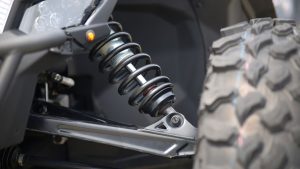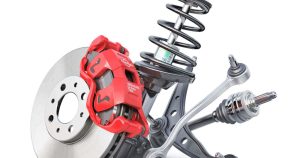When we think about driving comfort and control, most people imagine the engine, steering, or tires. Yet, one of the most critical factors influencing how your car behaves on the road lies in its suspension system — specifically the spring rates and damping forces. These two elements work together to ensure stability, ride comfort, and handling precision. Understanding their physics helps drivers appreciate why suspension tuning matters and how it can change the entire driving experience.

The Basics of Suspension Physics
At its core, a suspension system has two main goals:
-
Maintain tire contact with the road surface – ensuring maximum grip.
-
Absorb shocks from uneven terrain – keeping the ride comfortable and predictable.
This is achieved through the spring (elastic element) and the damper/shock absorber (energy dissipation element). Together, they form a mass-spring-damper system, one of the most fundamental models in physics and engineering.
The Role of Spring Rates
The spring rate measures how stiff or soft a spring is. It’s usually expressed as the amount of force required to compress the spring by a certain distance (e.g., Newtons per millimeter).
-
Soft springs → More comfortable, absorb bumps better, but allow more body roll and reduced handling precision.
-
Stiff springs → More control and sharper handling, but less comfort on rough roads.
Table: How Spring Rates Affect Ride Quality
| Spring Rate | Effect on Comfort | Effect on Handling | Common Use Cases |
|---|---|---|---|
| Low (soft) | Smooth ride, absorbs bumps | Increased body roll, less precise cornering | Family cars, luxury sedans |
| Medium | Balanced comfort and handling | Predictable cornering, moderate roll | Daily drivers, light SUVs |
| High (stiff) | Firm, less forgiving | Sharp handling, minimal roll | Sports cars, racing applications |
The ideal spring rate is always a compromise between comfort and performance, depending on the vehicle’s purpose.
The Role of Damping
Springs store energy when compressed, but without a damper (shock absorber), they would simply bounce up and down endlessly. The damper’s job is to control the rate at which the spring compresses and rebounds, turning kinetic energy into heat.
Types of damping characteristics:
-
Under-damped: Too soft, car feels bouncy and unstable.
-
Over-damped: Too stiff, car feels harsh and unresponsive.
-
Critically damped: Ideal balance, the car quickly stabilizes without extra oscillations.
Table: Damping Levels and Driving Experience
| Damping Condition | Ride Feel | Stability | Application |
|---|---|---|---|
| Under-damped | Floaty, excessive bounce | Poor grip in corners | Worn shocks, budget setups |
| Over-damped | Harsh, uncomfortable ride | High stability, but poor compliance | Heavy-duty trucks |
| Critically damped | Smooth, controlled | Excellent balance of comfort and control | Performance and modern adaptive suspensions |
The Interplay Between Spring Rate and Damping
The real magic of suspension lies in how these two forces interact. A stiff spring with soft damping creates instability, while a soft spring with stiff damping creates discomfort. Engineers carefully tune both elements together to achieve desired driving characteristics.
Example Configurations:
-
Luxury sedan: Soft springs + moderate damping → comfort prioritized.
-
Sports car: Stiff springs + strong damping → handling prioritized.
-
SUV/off-road: Medium springs + adaptive damping → versatility.
Advanced Suspension Technologies
Modern vehicles take suspension physics further with innovations such as:
-
Adaptive dampers – electronically controlled to adjust stiffness in real-time.
-
Air suspension – variable spring rates for comfort or performance.
-
Magnetic Ride Control – using magnetorheological fluids for instant response.
These systems allow drivers to experience both comfort and precision depending on conditions.
Practical Tips for Drivers
-
Don’t ignore suspension wear – old springs or worn shocks reduce safety and comfort.
-
Upgrade wisely – avoid mixing mismatched springs and dampers.
-
Match suspension to your driving style – commuters need comfort, enthusiasts want precision.
-
Check load ratings – carrying heavy loads on soft suspension can damage components.
Conclusion

Suspension physics is not just for engineers — it directly shapes how drivers experience the road. Spring rates determine how the car absorbs bumps, while damping controls stability and rebound. The right balance ensures comfort, control, and safety.
If you’re considering a suspension repair or upgrade, choose components carefully to match your driving needs. For high-quality parts, you can Buy Suspension online and ensure your vehicle maintains peak performance.